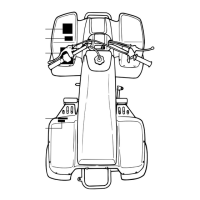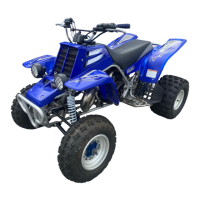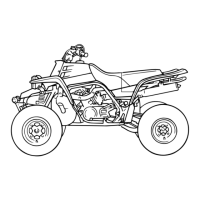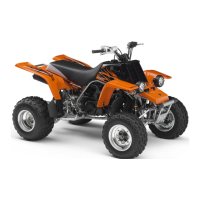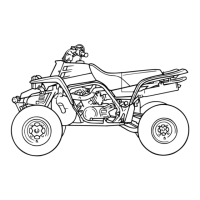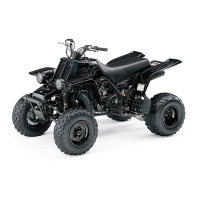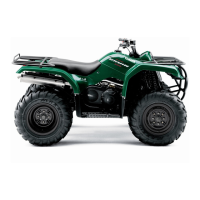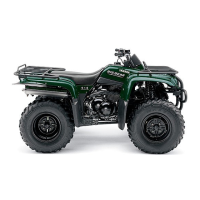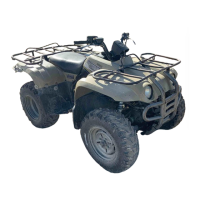Do you have a question about the Yamaha BADGER YFM80P and is the answer not in the manual?
Record key identification numbers for parts ordering and theft reference.
Details on the key identification number stamped on the key for ordering new keys.
Location and purpose of the vehicle identification number stamped into the frame.
Location and importance of the model label for ordering spare parts.
Functions of the main switch positions (ON/OFF) for starting and powering the vehicle.
Explanation of indicator lights, including the neutral indicator light.
Operation of the engine stop switch and start switch found on the handlebars.
How to use the throttle lever to control engine speed and its importance for safe operation.
Function and adjustment of the speed limiter for inexperienced riders.
Location and operation of the front brake lever for applying the front brake.
Location and operation of the rear brake pedal and lever for applying the rear brake.
How to apply and release the parking brake, especially on slopes.
Operation of the 3-speed transmission shift pedal and neutral position.
How to remove the fuel tank cap for refueling.
Operation of the fuel cock with its three positions (OFF, ON, RES) for fuel supply.
Use of the choke lever for starting cold engines and warming up.
Procedures for removing and installing the seat.
Check operation, condition, and free play of brakes; adjust if necessary.
Check fuel level and fill if necessary.
Check engine oil level and fill if necessary.
Check for oil leakage in the final gear case.
Check for proper throttle cable operation.
Check tire pressure, wear, and damage.
Check tightness of all chassis fittings and fasteners.
Check battery fluid level and fill with distilled water if necessary.
Step-by-step procedure for starting the engine in cold weather conditions.
Procedure for starting a warm engine, noting choke lever use and throttle.
Importance of warming up the engine for longevity and how to check if it's warm.
How to shift gears in the 3-speed transmission and engage neutral.
Steps for starting from a stop and accelerating, including gear shifting.
Proper procedures for slowing down, braking, and downshifting.
Crucial guidelines for the initial 20 hours of engine operation to ensure longevity.
Steps for parking the machine, including turning off the fuel cock and applying the brake.
Safe procedures for parking on inclines, including gear selection and wheel blocking.
Guidelines for choosing, installing, and using accessories and cargo.
Introduction to recreational riding and learning basic ATV techniques.
Emphasis on training, gradual familiarization, and safe operating practices.
Recommended protective gear including helmet, eye protection, gloves, and clothing.
Precautions when riding with extra loads or accessories, and maximum load limits.
Warnings against improper modification or accessory installation affecting handling.
Caution regarding the hot exhaust system and safe parking practices.
Warning against riding on paved surfaces, as ATVs are for off-road use only.
Importance of understanding terrain and avoiding hazards like holes and obstacles.
Advice on using caution flags for visibility in low-visibility areas.
Techniques for achieving maximum traction and proper turning maneuvers.
Riding techniques to avoid overturns on hills and proper weight transfer.
Techniques for safe downhill riding, weight shifting, and gear selection.
Proper weight positioning and steering for traversing sloping surfaces.
Guidelines for crossing shallow water safely, including brake checks.
Caution and procedures for riding on rough terrain, avoiding obstacles.
Techniques for controlling sliding and skidding on loose or slippery surfaces.
Troubleshooting common riding issues like turning problems or tipping.
Recommendation to carry the owner's manual and tool kit for basic maintenance.
Procedures for cleaning the machine to maintain appearance and performance.
Preventive measures for long-term storage of the ATV to prevent deterioration.
Key physical dimensions of the YFM80 model.
The basic weight of the YFM80 with fluids.
Technical details of the engine, including type, displacement, and bore/stroke.
Specifications related to the 3-speed transmission and gear ratios.
Details about the frame type, caster angle, and trail.
Tire type and size specifications for front and rear.
| Brand | Yamaha |
|---|---|
| Model | BADGER YFM80P |
| Category | Offroad Vehicle |
| Language | English |
